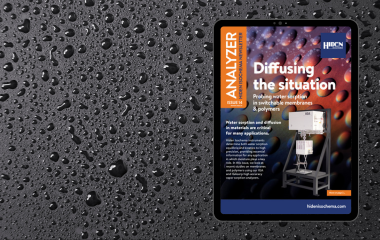What is Gas Sorption and How is it Measured?
Gas sorption is a fundamental process in which gas molecules adhere to the surface of a solid material. This adhesion is driven by the attractive forces between the gas molecules and the solid surface. Hence, sorption is an important indicator of key thermomechanical properties. The ability of a solid to sorb gas is often critical to end-use functionality, specifically in gas storage and separation, carbon dioxide capture, hydrogen fuel storage, jet fuel production, and more. Studying gas sorption is subsequently crucial in various scientific fields, including environmental science, material science, and energy research.
Measuring Gas Sorption: Gravimetric and Volumetric Methods
Gas sorption is affected by a number of properties, including pressure, desorption conditions, and adsorption feed composition. Understanding the variability of a material’s ability to sorb gas under different conditions is often essential to academic research and product development. Various methods are used to quantify the amount of gas sorption under variable conditions, but the most common are the volumetric and gravimetric techniques.
Volumetric Method
The volumetric method measures the change in pressure in a fixed volume due to the sorption of gas by the sample. The amount of gas sorbed is calculated based on the change in pressure and volume of the system.
Gravimetric Method
The gravimetric method, on the other hand, measures the mass of a sample before and after exposure to the gas of interest. The difference in mass is used to calculate the amount of gas sorbed.
In the gravimetric sorption technique, a sample is placed onto a microbalance, and the weight of the sample is measured continuously as a function of the applied temperature and pressure. Gas pressure is applied at programmed values, and sorption uptake is determined from the measured weight changes. The measurement chamber must either be evacuated or swept with inert gas before the start of a measurement.
There are several modes of operation for the gravimetric sorption technique, including static mode and active pressure regulation. In static mode, a pure gas is used at a range of pressures above vacuum, and the sorption uptake is measured to give an isotherm as a function of pressure. In active pressure regulation, the gas pressure is maintained at a constant value, and isobaric sorption kinetics are measured.
Gravimetric Gas Sorption Analysers
The XEMIS-001 from Hiden Isochema is a next-generation pure gas gravimetric sorption analyzer. It offers a wide controllable pressure range and is optimized for sample sizes from 1 mg to 5 g. The XEMIS-001 is designed for operation with a full range of gas and vapor species, including corrosives and flammables, making it a versatile tool for gas sorption studies.

The IGA-001, another of our products, is a dedicated single-component gas sorption analyzer for the study of gas interactions with both solids and liquids. It offers dynamic vapor sorption capabilities, which measures how much and how quickly a vapor or organic solvent is absorbed by a sample.
Understanding and measuring gas sorption is crucial for a wide range of applications, from energy production to environmental science. With advanced tools like the XEMIS-001 and IGA-001, researchers can accurately measure gas sorption under various conditions, providing valuable data for optimizing gas extraction processes.


